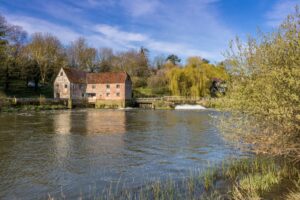Uncategorized
1,000-yr-old English Mill Rushed Back into Operation to Meet Demand

An ancient English mill is being reopened to serve the needs of its community. The traditional method of manufacturing flour is making a comeback. After a half-century hiatus, the Sturminster Newton Mill in Devon, England, has resumed production of critical supplies! The mill is one of several antique flour mills built along the Stour River. There is evidence that a mill existed on this site in 1016 AD under the reign of the Saxons.
People are presently in limited supply due to food shortages. As a result, Imogen Bittner and Pete Loosmore are putting their traditional abilities to good use by assisting the local community. “We have an edge over the larger mills in one regard,” Bittner told the Bournemouth Echo, “since they are used to selling enormous sacks to the wholesale trade and don’t have the machinery or people to pack the flour into little bags.”
Smaller amounts of flour are often produced to support the mill as a tourist attraction. This procedure, on the other hand, is on a whole different level. According to the Echo, “in only 10 days, they had milled a tonne of wheat – which is typically a year’s supply for the plant.” The surprise move “provided local merchants and bakers with 200 sacks of flour weighing 3.3lbs.”

In the process, much-needed revenue was earned for the company. It has been shuttered, like many other public places, while the present situation keeps people at home. Normally, the mill would only be open part-time, so this is definitely a departure!
When the mill closed in 1970, the place appeared to be done and dusted. Nonetheless, its rich history has resulted in it being a wonderful local landmark. It attracts many people due to its lovely setting on the River Stour. Since 1994, the Sturminster Newton Heritage Trust has been in charge. Loosmore was working behind the shift, restoring the machinery. It was a family concern for him; his grandpa had been the miller there for around 50 years. Loosmore told the BBC, “It’s been fantastic to bring the facility fully back to life and back into something like it used to be when it was functioning six days a week.”

There were multiple flour mills along the Stour, and this typical example, a Grade II listed edifice, highlights a 1,000-year industrial heritage in Sturminster town. In 2016, the remarkable millstone, er, milestone, was attained. The mill experienced the deadliest diseases in history over the years. Sturminster Newton Mill is well-known due to its mention in the Domesday Book (1086). In terms of novels, novelist Thomas Hardy resided nearby. In the neighborhood, he wrote his classic work The Return of the Native (1878).
When the present owners took it in 1994, they produced a Hallmark adaption starring Catherine Zeta-Jones, Clive Owen, and Joan Plowright. Exmoor National Park, on the other hand, was picked as the filming site! Hardy’s poems ‘Overlooking the River Stour’ and ‘On Sturminster Footbridge’ have apparent ties with the town, in addition to composing The Return of the Native.
How did the company function back then? “Until the start of the twentieth century, Sturminster Newton Mill was powered by a pair of undershot water wheels running side by side, driving four sets of stones,” according to the Sturminster Newton Museum Trust’s website. “The latest set of water wheels, fitted by William Munden of Ringwood in 1849, was capable of a combined output of 12 horsepower. The mill was modernized in 1904, and the two water wheels were replaced with a single water turbine.” (SM)




